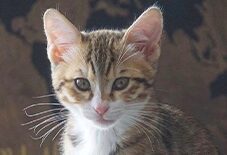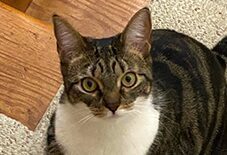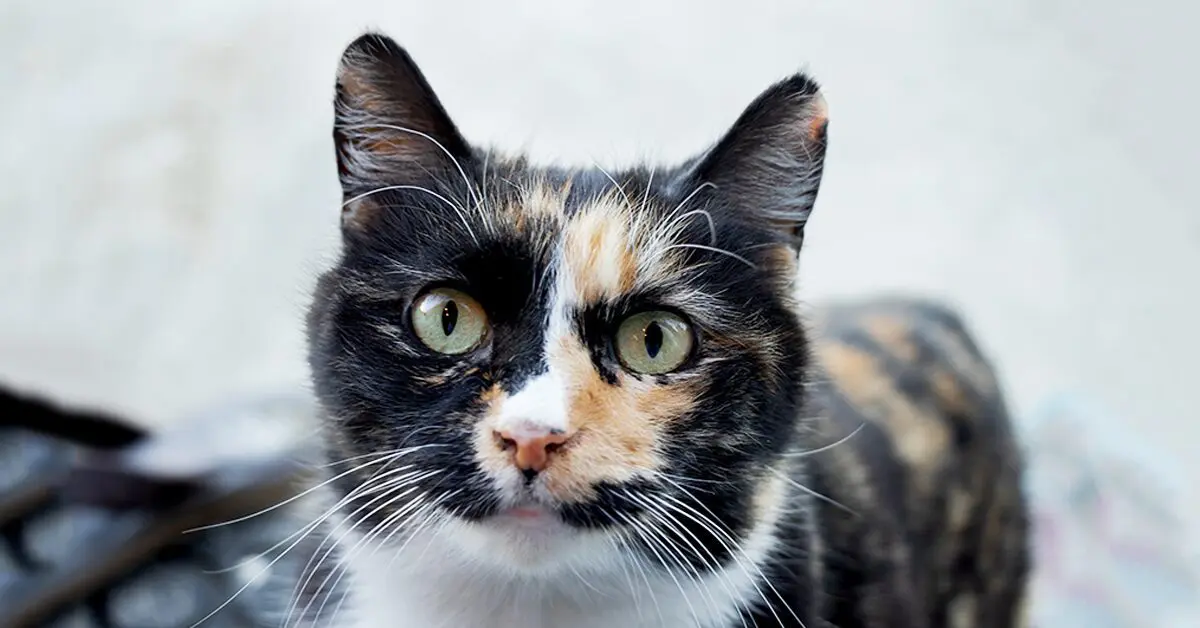
Meet the Manx
Best Fur Friend
High Kitty I.Q.
Top Cat Climber
Looking for a dog-like personality in a unique cat body? I’m the breed for you! We Manx are known for our lack of a tail, but what we lack in the tail department, we make up for in personality. I’m a gentle kitty with a big heart, so I’m great for families with kiddos and cat-friendly furbabies. Some humans think I act like a dog because I’m super loyal, I love to play fetch, and I can learn to do fun tricks. I’m really smart, too – I’ve been known to figure out how to open doors and cabinets (and my strong hind legs let me jump and climb around).
Interactive playtime is impawtant for me to get out my energy and also to spend more time with my humans! I will form a very strong bond with you and I’ll really miss you if I’m left alone for too long. Whether I’m shorthaired or longhaired, you’ll have to brush me at least once a week to keep me looking furbulous, but if you keep me healthy and happy, I will reward you by being your best friend furever.
Ready to learn more about me? Let’s dig in.
Ready to learn more about me? Let’s dig in.
 My Many Looks
My Many Looks
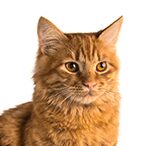
Mackerel Tabby

Tortoiseshell
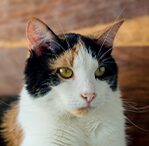
Calico

Blue Smoke
 My Breed Characteristics
My Breed Characteristics
 Furbulous Fact
Furbulous Fact
You may know us as the cat without a tail, but not all Manx are alike! The traditional Manx (those that can compete in the CFA’s Manx category) are shorthaired and either tailless (called “rumpys”) or have just a rise of bone for a tail (called “rumpy risers”). There are also “stumpies” (Manx with stubby short tails) and “longies” (Manx with normal-length tails). But there’s more! There are also longhaired Manx cats, which are called Cymrics, and they come in all tail lengths, too!
 As I Grow Up
As I Grow Up
As you can see, we Manx age pretty gracefully. Here are a few key milestones in my growth & development to be aware of as I grow up from a kitten to an adult and senior!

Kitten4 Mos.-1 Year
Get me used to hair & teeth brushing early on – I’ll love the attention, and treats always help!
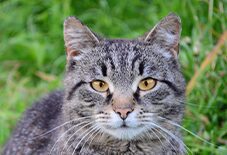
Adult3-5 Years
It takes me a while to reach my adult size! It’s important to watch my weight and make sure I have toys and cat trees for exercise.
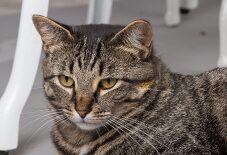
Senior8-9 Years
This is a great time for my human to start taking me for twice yearly checkups to make sure I stay healthy & happy.
 History of My Breed
History of My Breed
Because of our unique lack of a tail, the humans have come up with a lot of folktales surrounding the origin of us Manx cats. Some humans like to say that the first Manx was created because she was napping when Noah was loading all the animals onto his Ark, got there just as the Ark was closing, and got her tail lopped right off! Another favorite of the humans is that all Manx are descended from one tailless cat who sailed with the Spanish Armada and survived a shipwreck off the coast of Isle of Man, bringing the tailless gene to the island. None of these stories are true, of course, but we don’t mind being the stuff of legend!
The more likely story is that us Manx are the product of a spontaneous genetic mutation that occurred among the native cats on the Isle of Man, located in the Irish Sea between Great Britain and Ireland, which was isolated from the influence of other cat breeds. We were originally called stubbin in the Manx Gaelic language (a Celtic language spoken on the Isle of Man), but we soon took the name Manx from the land of our creation. Many humans think that longhaired Manx (or Cymrics) are the result of Norwegian Forest Cats coming to the island on the Viking ships and mixing with the local tailless population.
Manx cats are an old breed and competed in the world’s first cat shows in Great Britain. We were also one of the founding breeds when the Cat Fanciers’ Association was formed in 1906. But we’re more than just show cats! We are really good mousers and our winning combination of smarts and friendliness make us a prrrfect family pet. We can even learn to do tricks! We may not be one of the most common cat breeds around, but we are certainly one of the most unique (whether you believe the tall tales or not).
 Pawesome Cats to Parent
Pawesome Cats to Parent
In addition to purebred Persians like me, there are tons of prrrfectly sweet mixed-breed Persians that are looking to find their furever homes. You can learn where to find your next pet below!
 Care Tips
from Dr. Michelle Burch, Veterinarian
Care Tips
from Dr. Michelle Burch, Veterinarian 
Stay on top of your Manx’s grooming.
You should brush your Manx once or twice a week with a wide-toothed comb or rubber brush, but with an increased brushing frequency during shedding seasons in the spring and fall. Manx also need once daily tooth brushing to encourage dental health.
Make sure your Manx gets daily exercise.
Manx should have 30 to 60 minutes of play a day to help expend their energy. I recommend playing with lures, mice, or cat tunnels. Manx have strong hind legs and love to jump and climb, so a cat tree makes a good addition to your home.
Be proactive about joint health.
Since Manx is a tailless breed, they can easily develop arthritis in their pelvis and spine, resulting in chronic pain. Starting a glucosamine, chondroitin supplementation, and fish oil supplementation will help encourage joint health at an early age.

 Why Get Cat Insurance?
from Pumpkin®
Why Get Cat Insurance?
from Pumpkin®
While Manx are a generally healthy breed, cat-astrophes can happen to any cat at any age. If your kitty gets hurt or sick, pet insurance can help you say ‘yes’ to the best care, even when it’s costly. When it comes to shopping for this breed, you’ll want to choose insurance plans like Pumpkin's, which can help cover the costs associated with the hereditary conditions Manx are prone to developing. While a reputable breeder will conduct genetic testing on your kitty’s parents to help minimize the chances of passing down hereditary conditions, they can’t always be avoided. Let’s look at some common ones, and how Pumpkin Cat Insurance plans could help cover the cost of care!
 Heart Disease
Heart Disease
Manx may develop heart problems, specifically Hypertrophic Cardiomyopathy (HCM). In this condition, the muscle walls of the heart thicken causing a decline in cardiac function. While there is no cure, heart disease can be managed with medication and dietary changes.
- Cost to Treat
- $500-$3,000
- Pumpkin Pays Back*
- $450-$2,700
 Spina Bifida
Spina Bifida
Spina Bifida is one of many conditions (called Manx Syndrome) that Manx are genetically predisposed to. With this condition, the vertebrae do not develop properly, leaving gaps where the spinal cord is exposed. Mild cases can be treated surgically and with physical therapy.
- Cost to Treat
- $500-$3,000
- Pumpkin Pays Back*
- $450-$2,700
 Periodontal Disease
Periodontal Disease
Periodontal (gum) disease occurs when plaque builds up, forming a layer of tartar that inflames the gums. Left untreated, gums weaken and separate from teeth. While routine brushing, cleanings, and antibiotic gels help treat milder cases, severe ones require surgery.
- Cost to Treat
- $400-$1,200
- Pumpkin Pays Back*
- $360-$1,080
 Corneal Dystrophy
Corneal Dystrophy
Manx are predisposed to this eye condition, in which lesions appear on the cornea, causing pain and severely impairing vision. This condition can be treated using antibiotics and, in some cases, surgery may be required.
- Cost to Treat
- $200-$1,000
- Pumpkin Pays Back*
- $180-$900
*Example illustrates reimbursement of a covered vet bill at a 90% reimbursement rate, where the annual deductible had already been satisfied and the annual limit had not yet been met. Coverage and reimbursement results vary based on policy options.

